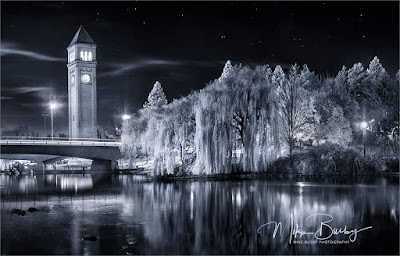Infrared Photography - an Introduction - Mike Busby Photography
Infrared Photography – by Mike Busby
I want to create photographs that stretch the imagination. They need to capture attention and compel the mind toward creative reflection. I want images of the familiar, but with shifts into the new and the unknown. While there are many techniques to do this, few are more striking and immediate than infrared photography.
 |
| The Meadow |
When done well, infrared creates worlds with dark skies and white landscapes. It creates surreal vistas that are as real as any black and white photograph. The images may look different, but the camera is recording very real and natural light. Infrared is not an effect, but an honest and alternate way to view the world.
 |
| Still Nights - 30 sec at f8, ISO 200 |
Infrared in photography generally refers to “near infrared.” This portion of the light spectrum is just beyond the visible realm. Foilage and things that are green reflect the most light, and they are recorded as white. Areas that don’t reflect infrared light, such as blue skies, are recorded as shadows and blacks.
 |
| Latah Creek - 1/750th at f8, ISO 400 |
As with most areas of photography, there are many views and approaches to infrared. There’s a wide breadth of sensor and filter choices that span the ultra-violet, the visible, and the infrared spectrums. Some people use complex Photoshop techniques to process images while others use simpler solutions. This article is directed toward camera conversions using the standard infrared sensor, the 720nm, and simple and effective processing techniques.
Camera Conversion versus Filter
Photographers can use on-lens infrared filters, or they can convert their camera to infrared. On-lens filters are extremely dark and they require long exposures and tripods. Camera conversions, however, allow photographers to photograph in the same manner and settings as conventional cameras. With camera conversions, the filter in front of the main sensor is replaced with an infrared filter. However, it is a permanent modification. I use a converted Nikon D7100 using the 720nm infrared filter. 720nm is a standard, and 720 references the wavelengths where the visible spectrum ends and the infrared realm begins. This sensor catches near-infrared light and a sliver of reds and magentas — hence the monochromatic colors. The 720nm provides numerous processing choices, and I have found it to be quite versatile.
 |
| Spokane in Blue - 15 sec @ f8, ISO 400 |
Lens Selection and Live View.
I recommend converting cameras that have live view capabilities and to research how well your existing lenses will work. Modern cameras are calibrated for visible light, but infrared travels at different frequencies. This means focus may or may not occur when focusing through the viewfinder. However, consistently good focusing occurs at the plane of capture while using live view. For example, my Nikon 18-200mm lens focuses well through the viewfinder, but the Nikon 10-24mm is blurry. However, I get solid results with both lenses when live-view is used
Not all lenses are created the same, and not all lenses work well with infrared. Kolarivision has a database of lenses, for the brand name manufacturers, that report which lenses do well, and which ones do not. A poor performer will have a hotspot in the center - an area that is muddy and visually unappealing. Good performers are clear and sharp throughout the image. The Kolarivision database can be found at this address: https://kolarivision.com/articles/lens-hotspot-list/
 |
| Midnight on the Palouse |
White Balance and Processing:
Some cameras can preset white balance for infrared, and others cannot. Files that are not white balanced will appear similar to figure 1.1 with varying levels of reds and magentas. Files accurately white balanced in-camera will look like figure 1.2. It’s not an issue if your camera cannot preset for infrared white balance — it will simply occur in processing.
To white balance an image like figure 1.1, just use the white balance tool in camera raw or Lightroom, and select something in the image that would normally appear green. Again, green in infrared reflects the most light and should appear as white in the final image. Once you have an image resembling figure 1.2, then use the tonal sliders to extend the blacks and the whites in the same manner as conventional images. This adds contrast and forms the basis for good prints — Figure 1.3. From there, use your creative processing styles to form the image as you wish — Figure 1.4.
It’s too easy to view infrared as an effect, and forget to include and emphasize design elements. Stronger images still contain leading lines, forms, shapes, and solid composition. “Out There” was photographed in an old grange hall. An off-camera flash was added to light the room and to add textures. “Still Nights” is an example of long-exposure infrared at night. The infrared picked up the stars despite the strong light pollution. Finally, “Latah Creek” was an infrared image where the whites and shadows were lifted to create a dreamy sketch-like effect.
 |
| Out There 1/250th at f7.1, ISO 200 |
Infrared changed how I view photography, and to an extent, how I view the world. It is not for everybody, and converting a camera requires a little research and a complete commitment — because you cannot go back. However, infrared opens new levels of photography, and if you become passionate about it, then it will change your view of photography, and you’ll start creating surreal images that strike directly to the imagination.
Thanks for reading and you can see more of my work at:
Busbywc.com
Facebook - Mike Busby Photography
(509) 995-2954

Comments
Post a Comment